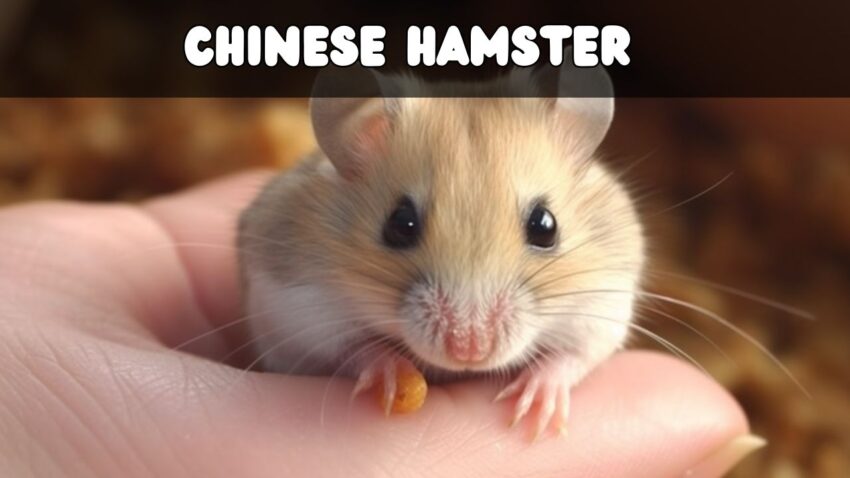Hello, fellow rodent enthusiasts and curious readers! Today we delve deep into the fascinating world of the Chinese Hamster, a species renowned for its distinctive appearance and captivating personality. Whether you’re considering bringing one of these delightful creatures into your home or simply wish to expand your knowledge on the subject, you’ve come to the right place.
In this comprehensive guide, we will be navigating through various critical facets that sculpt the life of a Chinese Hamster. From understanding their natural habitats to unraveling the details of their physical characteristics, we aim to equip you with a profound understanding of this unique species. Our exploration will encompass a spectrum of topics including their behavior and temperament, diet and nutrition necessities, and ideal housing environments. Not to be left uncharted, we will also touch upon the vital areas of health and wellness, breeding practices, and will address frequently asked questions that resonate with both prospective and current Chinese Hamster caregivers.
As we venture into the wonderful world of the Chinese Hamster, we invite you to immerse yourself in the charm that defines this species, standing tall with its rich history and captivating personality. Get ready to be captivated by the Chinese Hamster, a pet that offers both companionship and a sprinkle of joy in your daily life. Stay tuned as we unravel the details that make the Chinese Hamster a truly special member of the rodent family.
Overview
Historical Background

Originating from the deserts and arid regions of Northern China and Mongolia, the Chinese Hamster has navigated a fascinating journey from being a wild creature to becoming a cherished pet in homes around the world. While they are indeed part of the hamster family, they share a closer genetic relationship with rats and mice, which elucidates their slightly elongated bodies and rat-like tail, distinguishing them from their hamster cousins.
As we venture back in time, it is discovered that the initial recognition and study of the Chinese Hamster can be traced back to the early 20th century. It was during this period that they were first scientifically documented, opening a doorway to deeper exploration and understanding of this species.
Domestic and Wild Habitats
In the wild, these little creatures are known to inhabit burrows, which they ingeniously construct to shield themselves from predators and harsh environmental conditions. The burrows also play a pivotal role in regulating their body temperature, providing a cool sanctuary during the hot days and a warm retreat during the cold nights.
As for their life in domestic settings, the Chinese Hamster has found a loving home in the hearts of many pet enthusiasts across the globe. Their relatively low maintenance and delightful personalities have rendered them a popular choice for families, individuals, and even classrooms. They are notably observed to be more nocturnal in a home setting, becoming active and exploratory primarily during the evening hours.
In the bustling pet market, you’ll commonly find two varieties of Chinese Hamsters: the standard wild type and the dominant spot, which carries a distinct white coat adorned with a charming patchwork of colored spots.
Community and Conservation
Despite their widespread adoption as pets, it is pertinent to note that in the wild, the Chinese Hamster population is currently not under any immediate threat, maintaining a stable presence in their natural habitats. However, like all species, they benefit from conscious and responsible pet ownership, which includes ethical breeding practices and habitat conservation to ensure their well-being both in homes and in the wild.
As we immerse deeper into this guide, we strive to equip you with all the knowledge you need to understand, nurture, and cherish the vibrant life of a Chinese Hamster, fostering a nurturing environment that echoes their natural habitat, fulfilling not just their basic needs but also catering to their curious and lively disposition.
Natural Habitat

Geographic Origin and Climatic Adaptations
To truly appreciate the Chinese Hamster, one needs to venture into their natural habitat, an environment rich with unique features that foster their survival. Native to the sandy deserts and scrublands of Northern China and Mongolia, this species has evolved remarkably to thrive in a habitat marked by extreme climatic conditions, with hot days and cold nights characterizing their natural environment.
In the wild, they have adapted to their dry surroundings by developing behaviors and physical attributes that aid in moisture retention and temperature regulation. Their kidneys, for instance, have evolved to limit water loss, allowing them to stay hydrated while consuming a minimal amount of water. Moreover, the Chinese Hamster has a keen instinct for burrowing deep into the cool earth to escape the daytime heat and maintain a steady body temperature.
Landscape and Flora
Geographically, the regions they inhabit are marked by expansive landscapes dominated by sparse vegetation, where shrubs and grasses are the predominant plant life. This landscape not only offers them a vast area to forage but also provides the necessary materials for nest construction within their burrows. The vegetation type directly influences their diet, which predominantly includes seeds, grains, and occasional insects, a diet rich in nutrients and sufficiently available in their natural habitat.
Burrowed Life and Predator Avoidance
One of the remarkable adaptations of Chinese Hamsters to their natural habitat is their proficient burrowing skills. The intricate underground tunnels they create serve as a secure home base, offering protection from a variety of predators including birds of prey, snakes, and larger mammals. These burrows are designed with multiple exits, allowing for a quick escape in case of an intrusion.
This underground lifestyle is further supported by their excellent sense of hearing and smell, which they employ to navigate their surroundings and detect potential threats with impressive accuracy. Their nights are spent foraging for food under the cover of darkness, a strategy that aids in predator avoidance while allowing them to exploit a niche where competition for resources is relatively low.
Seasonal Adaptations and Activities
Chinese Hamsters are crepuscular creatures, being most active during the early morning and late evening hours, a routine that helps them avoid the harsh conditions associated with daytime heat and nighttime cold in their arid habitats. The seasonal changes also affect their activities; during the cold winter months, they exhibit a tendency to hoard food in their burrows, displaying a remarkable foresight in ensuring their survival through harsh conditions.
As we delve deeper into understanding the Chinese Hamster’s natural habitat, it becomes evident that their entire lifestyle, from feeding habits to burrowing instincts, is a testament to their remarkable adaptation to a challenging environment, showcasing a resilience and ingenuity that is nothing short of awe-inspiring. This understanding serves as a foundational pillar in replicating a nurturing habitat when we bring them into our homes, respecting their innate nature and catering to their inherent needs.
Physical Characteristics

Size and Body Structure
Let’s paint a vivid picture of the physical characteristics that make the Chinese Hamster a truly unique specimen in the rodent family. Typically, these petite creatures range in size from 7.5 to 9 cm in length, a diminutive stature that beautifully aligns with their agile and nimble nature.
Their body is streamlined, designed for sleek movements through their natural habitats, characterized by a more elongated body compared to other hamster species. This trait particularly aids them in swiftly navigating through the intricate tunnels they build in the wild.
Fur Coat and Color Patterns
As we explore the Chinese Hamster’s coat, we notice a delightful array of color patterns that are primarily brown with a dark stripe running along their spine, blending gracefully with a creamy, white belly. This color scheme not only adds to their aesthetic appeal but also facilitates camouflage in their natural habitats, aiding in predator evasion. As breeders have worked with these creatures, we’ve seen the introduction of new color variants including the “spotted” and “dominant spot” which offer a varied pattern of white spots on their fur.
Distinguishing Features
When you take a closer look, one of their distinguishing features is their round, protruding eyes that offer them a wide field of vision, a crucial attribute in the wild. Their ears are relatively large compared to their head size, enhancing their acute hearing which is pivotal for survival in their natural habitat.
Coupled with this, their small, yet nimble limbs end in tiny paws equipped with sharp claws, perfected for digging and burrowing, a testament to their fantastic burrowing lifestyle. The tail too deserves a special mention; it is unusually long for a hamster, often reaching up to a third of their body length, providing an added balance and agility to their movements.
As you immerse yourself in the fascinating world of Chinese Hamsters through these high-quality images, you begin to appreciate the delicate yet robust nature of these creatures, equipped beautifully, both aesthetically and functionally, to thrive in their specific environments while captivating the hearts of enthusiasts around the world.
Behavior and Temperament

A Glimpse into their Behavior
The Chinese Hamster carries itself with a demeanor that is a captivating blend of agility, curiosity, and caution. A nocturnal creature, it comes alive during the night, exhibiting a vibrant energy that’s coupled with a high level of alertness to its surroundings. This behavior is not just an inherent trait but also a survival strategy rooted in avoiding daytime predators in their natural habitat.
It is known for its climbing agility, owing much to its elongated body and the good grip provided by its dexterous limbs. Whether in the wild or in captivity, it actively explores its environment, often climbing up cages and even managing to squeeze through tight spaces with remarkable ease.
Unique Traits and Quirks
The Chinese Hamster is not just all agility and speed; it has its endearing side, brimming with quirks that are sure to steal your heart. For starters, they have a pronounced grooming behavior, often seen meticulously cleaning themselves to maintain a sleek and shiny coat, a testimony to their clean and organized nature.
Another captivating characteristic is their food hoarding behavior. They tend to store food in their cheek pouches, a sight that is as fascinating as it is adorable, to ensure they have a steady food supply at their disposal. It’s not uncommon to find a Chinese Hamster’s sleeping area surrounded by a stash of food, neatly gathered over time.
Despite their active and exploratory nature, they are known to be relatively more docile and less aggressive compared to some other hamster species, which makes them relatively easier to handle and ideal for families, including those with children.
Solitude and Companionship
A notable trait in their temperament is their propensity for solitude. They are largely solitary creatures, which means they fare better when housed individually. This solitary nature traces back to their wild counterparts who predominantly prefer to carve out territories for themselves, marking their space distinctly to avoid conflicts.
However, with gentle and gradual socialization, they can learn to enjoy human companionship, showing affection and even developing bonds with their human caretakers, bringing joy and a sense of connection that is truly fulfilling.
Through understanding the rich tapestry of behaviors and temperaments exhibited by the Chinese Hamster, enthusiasts can foster a nurturing and harmonious environment for these adorable creatures, meeting their unique needs while enjoying their delightful quirks and traits.
Diet and Nutrition

The Fundamental Nutritional Needs
When it comes to ensuring the health and wellness of a Chinese Hamster, providing a diet that closely mirrors what they would naturally consume in the wild is pivotal. This means a balanced diet rich in grains, seeds, and nuts should be a staple. These tiny omnivores also appreciate a variety of fresh fruits and vegetables, making up a smaller yet essential part of their dietary regime.
It’s important to note that their digestive systems are finely tuned to handle a diverse array of foods. This allows them the pleasure of enjoying little treats such as mealworms and crickets, offering them a source of protein that is not only nourishing but also aligns with their natural predatory instincts.
Special Dietary Requirements
Though Chinese Hamsters have a good appetite and are known to enjoy a diverse diet, they do have specific dietary needs and restrictions that owners need to be aware of. Being prone to diabetes, it is essential to moderate the intake of sugary foods including fruits which are high in sugar content. Offering fruits such as apples and pears should be done sparingly, perhaps as a weekly treat rather than a daily indulgence.
Also, not all vegetables are suitable; foods with high water content like lettuce should be avoided as they can lead to diarrhea. Instead, lean towards offering crunchy vegetables such as carrots and bell peppers which not only satisfy their need to gnaw but also provide essential nutrients.
Whisker Tips for Feeding Chinese Hamsters
To keep your furry friend healthy and happy, it is recommended to feed them a well-measured portion to prevent obesity, a common issue in domestic hamsters. Moreover, always ensure they have access to fresh and clean water, preferably through a drip bottle to maintain hygiene.
Lastly, it’s a thoughtful gesture to occasionally offer them tiny bits of hard-boiled eggs, cooked plain chicken, or low-fat cheese as a protein boost, ensuring a balanced diet that caters to all their nutritional needs.
Through a comprehensive understanding of the Chinese Hamster’s dietary preferences and nutritional requirements, owners can foster a healthy life for their pets, marked by vibrancy and joyful exploration. After all, a well-fed hamster is a happy hamster, and meeting their dietary needs ensures a life full of wheel-y good times!
Housing and Environment

Finding the Perfect Home: Cage Size and Type
A comfortable, spacious, and secure living environment is at the heart of nurturing a happy and healthy Chinese Hamster. For these petite creatures, a minimum cage size of 24 x 12 x 12 inches (60 x 30 x 30 cm) is recommended to offer them ample space to explore, play, and nest. Wire cages with a solid bottom are typically the go-to choice as they provide excellent ventilation and easy viewing. However, ensure that the bar spacing is narrow enough to prevent any escape adventures.
When crafting their living space, consider incorporating a variety of zones that cater to their natural behaviors, including areas for burrowing, foraging, and climbing. These different zones can be created using a mix of platforms, hideouts, tunnels, and ladders to encourage physical activity and mental stimulation.
The Bedding Foundation: Comfortable and Safe
Equally essential to a Chinese hamster’s housing setup is choosing the right bedding. Opt for a bedding material that is soft, absorbent, and dust-free to foster a clean and allergen-free environment. Paper-based beddings are often favored as they meet these requirements and are also easy to replace. A substantial layer of bedding, around 2 to 3 inches deep, encourages their natural burrowing instincts and offers comfort for their delicate bodies.
Moreover, steer clear of cedar or pine wood shavings as they contain harmful oils and aromatics that can adversely affect a hamster’s respiratory system.
Environmental Considerations: Temperature, Lighting, and Accessories
Chinese hamsters thrive in a stable environment where the temperature is maintained between 65 to 75°F (18 to 24°C). It’s vital to place their habitat away from direct sunlight, drafts, and noisy areas to ensure a peaceful, stress-free dwelling. Additionally, the lighting should follow a natural day and night cycle to support their circadian rhythms.
When it comes to accessorizing their abode, focus on enriching their environment with safe and stimulating toys. Think exercise wheels with solid surfaces, chew toys to help maintain healthy teeth, and sand baths for grooming and entertainment.
Whisker Tips for Housing Chinese Hamsters
Remember, the goal is to replicate their natural habitat as closely as possible. This involves regular cleaning to maintain hygiene and carefully choosing the right mix of accessories to cultivate a home that is both fun and safe. Embrace the creative process, while always prioritizing their natural behaviors and needs. It is not just about housing; it is about crafting a haven of happiness for your furry companion.
Implementing a well-thought-out housing and environment strategy is the cornerstone of encouraging a vibrant and fulfilling life for your Chinese Hamster, laying the foundation for a wheel-y happy hammy home!
Health and Wellness

Overview: General Health Needs
Delving into the intricate world of the Chinese Hamster’s health and wellness, it becomes glaringly apparent that maintaining a proactive stance on their wellbeing is not just a necessity but a responsibility for every pet owner. Like every other living being, the Chinese Hamster has distinct health needs that are vital to sustaining a fulfilling and comfortable life.
Common Health Issues: What to Watch Out For
In their lifespan, which typically spans 2 to 3 years, Chinese Hamsters may encounter a series of health issues. One of the common problems is respiratory infections, which can be recognized by symptoms such as sneezing, wheezing, and discharge from the nose or eyes. Early intervention can be a lifesaver, so be vigilant about changes in their respiratory patterns.
Digestive issues are another common health concern, often stemming from improper diet or sudden changes in their food type. Wet tail, a severe diarrheal disease, is a particular threat to hamsters and requires immediate veterinary intervention.
Additionally, Chinese Hamsters are prone to developing tumors, especially as they age. Regular check-ups can aid in early detection and proper management of these growths.
Preventative Measures: Steering Clear of Trouble
Prevention is always better than cure. Ensuring a clean habitat, balanced diet, and regular exercise can fend off many health issues before they become serious. Moreover, taking steps to minimize stress by providing a quiet, stable environment plays a crucial role in maintaining their overall health.
Vet Consultation: Recognizing When It’s Time
Being attentive to your hamster’s behavior and physical condition is critical. Signs of lethargy, changes in eating habits, or alterations in their grooming routine signal that it’s time for a vet consultation. Having a trusted vet on call, who is experienced with small animals, ensures you have the necessary support to navigate through health concerns adeptly.
Whisker Tips: Keeping Your Chinese Hamster Healthy
Remember, a key part of fostering wellness is regular observation. Daily interactions not only foster a deeper bond but allow you to notice any unusual signs early on. Combining love with attentive care will surely pave the way for a wheel-y healthy and happy Chinese Hamster, accentuating their naturally joyful and vibrant selves.
Engaging with the delicate dynamics of the Chinese Hamster’s health and wellness necessitates a caring and vigilant approach, nurturing them to lead not just a healthy, but a joyous life. Remember, a vibrant Chinese Hamster translates to a wheel-y happy you!
Breeding

Introduction to Chinese Hamster Breeding
Breeding Chinese Hamsters is a task that involves deep knowledge and understanding of the biological and physiological attributes of these creatures. Before diving into the breeding process, it is crucial to ensure that you are well-versed with the species and equipped to care for not just the adult hamsters, but the potential offspring that will emerge from the breeding process.
Breeding Conditions: Setting the Stage Right
Setting up the right conditions is pivotal in ensuring a successful breeding process. Chinese Hamsters reach sexual maturity at around 2 to 3 months of age, and it is generally recommended to pair females and males who are of similar age to prevent any form of aggression.
Creating a conducive environment involves setting up a clean and secure habitat with ample space, providing nutritious food, and ensuring a stress-free environment. The breeding area should be tranquil and away from loud noises to facilitate comfortable and safe breeding.
Practices: Guiding Principles of Responsible Breeding
Breeding involves several practices that are tailored towards ensuring the health and well-being of both the parents and the offspring. To initiate breeding, introduce the female to the male’s territory, as this can potentially reduce aggressive encounters.
Monitoring the breeding pair for signs of aggression and separating them when necessary can prevent harm. Once the breeding is successful, it is crucial to provide the pregnant female with a nourishing diet and a comfortable nesting area to foster healthy offspring.
It’s essential to be ready to accommodate the babies, which usually number between two and twelve in a litter, and provide them with the necessary care, which includes separating them by gender at the appropriate age to prevent inbreeding.
Ethical Considerations: Breeding with Conscience
Engaging in breeding brings along a considerable ethical responsibility. Prospective breeders must be committed to providing lifelong care for all the hamsters born. It is also the breeder’s duty to find responsible and loving homes for all the offspring, a task that is not always easy.
Furthermore, engaging in breeding should be accompanied by an awareness of the overpopulation issues facing pets globally, and a dedication to only breeding in a responsible and sustainable manner. Prioritizing the welfare of the hamsters over any other considerations should be the guiding principle in breeding endeavors.
Whisker Tips: Breeding Advice for Beginners
If you are new to breeding Chinese Hamsters, it is advisable to start with comprehensive research and possibly seek mentorship from experienced breeders. Ensuring you have all the necessary knowledge and resources will set a foundation for a successful and ethical breeding journey.
Stepping into the sensitive yet enriching domain of Chinese Hamster breeding demands not just knowledge and resources, but a heart steeped in care and responsibility. Remember, creating a loving home for these new lives ensures a wheel-y happy and fulfilling life for them, painting smiles on faces, one hamster at a time.
FAQs

Getting to Know Your Chinese Hamster: Your Questions Answered
Welcome to our FAQ section where we dive deep into the world of Chinese Hamsters to answer the burning questions you, as current or prospective owners, might have. We understand that caring for such a unique species comes with a plethora of questions and we’re here to offer the expertise to guide you on this journey.
What is the Lifespan of a Chinese Hamster?
Chinese Hamsters have a lifespan of 2-3 years, although with optimum care, they might live a bit longer. It is important to provide them with a healthy diet, a safe habitat, and regular veterinary check-ups to ensure a long, healthy life.
What kind of Habitat Do Chinese Hamsters Prefer?
In captivity, Chinese Hamsters thrive in spacious environments that mimic their natural habitats. Provide a bedding of aspen or paper-based substrate, along with hiding places and tunnels for them to explore. The cage should be secure to prevent escapes and protect them from potential predators.
Are Chinese Hamsters Nocturnal?
Yes, Chinese Hamsters are primarily nocturnal, which means they are most active during the night. However, they may have periods of activity during the day too. It is advisable to place their habitat in a quiet location to let them have undisturbed sleep during the day.
What Do Chinese Hamsters Eat?
A balanced diet for Chinese Hamsters includes high-quality hamster pellets supplemented with fresh fruits, vegetables, and occasional treats of nuts and seeds. Ensure that the fresh produce is washed properly to remove any pesticides, and always remove uneaten fresh food to prevent it from rotting.
Can Chinese Hamsters Live Together?
Chinese Hamsters are more solitary compared to other hamster species and might exhibit signs of aggression if housed together. It is generally recommended to house them singly to prevent potential fights and injuries.
How Often Should I Clean the Hamster’s Cage?
To maintain a healthy environment, it is advisable to clean the cage thoroughly at least once a week. Daily spot cleaning to remove soiled bedding and uneaten food is also recommended.
Can Chinese Hamsters Be Trained?
Yes, with patience and time, you can train your Chinese Hamster to do simple tricks and to be comfortable being handled. It is advised to start slowly and use treats to encourage positive behavior.
Do They Require Veterinary Care?
Absolutely, like all pets, Chinese Hamsters benefit from regular veterinary check-ups to monitor their health and to address any health concerns promptly.
Conclusion
We hope that this FAQ section has been helpful in addressing some of the common questions regarding Chinese Hamsters. Remember that being well-informed is the first step to providing a loving and nurturing home for your furry friend.
Final Remarks

As we come to the end of this comprehensive guide on the Chinese Hamster, it is time to reflect upon the vivid tapestry we have woven together through this journey into the fascinating world of one of the most charming rodent species. Through the in-depth insights into their habitat, unique physical attributes, and behavioral traits to the essential guides on their diet, housing, and healthcare needs, we have left no stone unturned in providing you with the all-encompassing knowledge to be the best Chinese Hamster guardian you can be.
Recap of the Journey
- Natural Habitat: A reminiscent journey through the wild terrains where Chinese Hamsters originally hail from, giving you a glimpse into the environments they thrive in naturally.
- Physical Attributes: We navigated the distinct physical characteristics that make Chinese Hamsters a unique species, emphasizing their size, color patterns, and distinguishing features accompanied by high-quality visuals.
- Behavior and Temperament: The delve into their quirky and distinct behavioral patterns offered you a window into their temperament, aiding in fostering a stronger bond with your pet.
- Diet and Nutrition: Guiding you through the dietary needs and preferences, we armed you with the knowledge to nurture a healthy and happy Chinese Hamster.
- Housing and Environment: Shedding light on the perfect habitat setup, we focused on creating a haven that replicates their natural habitat.
- Health and Wellness: We discussed the quintessential healthcare regime to ensure a vibrant, and disease-free life for your hamster, focusing on preventive measures and signs that dictate a vet visit.
- Breeding: Bringing forth the ethical considerations surrounding breeding, we encouraged a responsible approach to bringing new life into the world.
A Call-to-Action
As you stand enriched with a repository of knowledge on the endearing Chinese Hamsters, we urge you to become responsible advocates for this species. Share this wealth of information with fellow enthusiasts and prospective pet parents, encouraging a nurturing and informed approach to adopting and caring for these delightful creatures.
Adopting a Chinese Hamster is not just bringing a pet home; it is about embracing a joyous responsibility. Therefore, we warmly invite you to share this article far and wide, to foster a community of well-informed Chinese Hamster guardians, bound by the shared love and respect for these adorable beings.
In conclusion, whether you are at the beginning of your journey as a Chinese Hamster owner or looking to enhance your knowledge, we hope this guide has served as a beacon of information, guiding you towards responsible and joyous pet parenting.
Remember, adopting responsibly not only ensures a happy home for your hamster but contributes positively to the larger ecological balance. Let’s walk this path together, creating a harmonious habitat for our furry friends. Thank you for being a part of this insightful journey.

